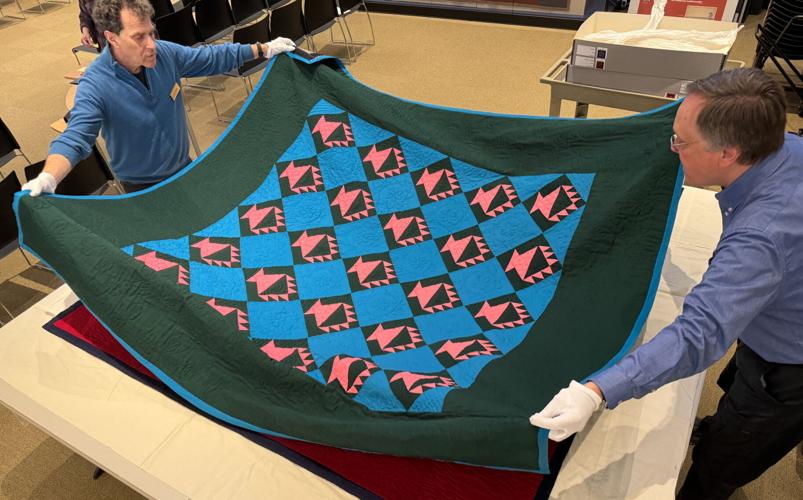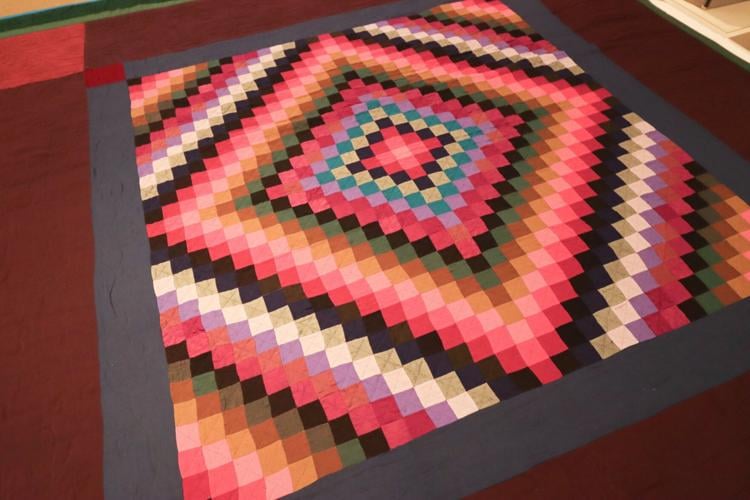LANCASTER, Pa. — A historic group of hand-made Lancaster County Amish quilts — some dating to the late 1800s — was center stage in a “Collections Up Close” program March 23 at the LancasterHistory museum on North President Avenue.
Quilts from the iconic Esprit Quilt Collection, curated by Dr. James McMahon, LancasterHistory’s curator and director of collections, were presented in a quilt turning program.
The Esprit collection was acquired by LancasterHistory in 2013 from the Heritage Center Museum of Lancaster County which, through a $1 million fund-raising effort in 2002, purchased 82 Amish quilts from the collection of Esprit’s founder Doug Tomkins.

Dr. James McMahon inspects a popular “Bars" design quilt from the 1920-30s with an intricate green diamond boarder.
The Amish quilts were a major part of a huge collection put together by Susie and Doug Tompkins, co-founders of the fashion and outdoor clothing brands Esprit and North Face.
In two sessions at the quilt program, small groups of quilt lovers got a close look at a small selection of the Esprit quilts — each representing a different style created by Amish women, according to McMahon. The quilts date from the 1880s through the 1940s.
The Collections Up Close series allows staff to highlight parts of the museum’s vast collection in a conversational setting where participants hear stories about the collections and their cultural significance to Lancaster County and American history.
The Esprit collection dates to a 1971 visit the Tomkinses made to the Abstract Design in American Quilts exhibit at the Whitney Museum of American Art in New York City. Soon after their visit, they started to purchase quilts of both unique design and historical significance — many created by Amish women in Lancaster County.

Intricate hand stitching design in the green diamond boarder of a circa 1920-1930 “Bars” quilt of pieced wools with geometric boarder.
Quilts soon filled the walls of Esprit’s San Francisco headquarters and it was open to visitors to take self-guided tours. Over time, the Tompkinses began purchasing only Amish quilts favoring the strong graphics and simplicity of the Lancaster Amish quilt- making community.
By 1990, Esprit owned more than 350 quilts and Tompkins created a coffee table book titled “AMISH: The Art of the Quilt” (Knopf, September 1990) featuring his Lancaster quilts. Tompkins also organized a major exhibition of them at the Fine Arts Museum of San Francisco.
In 2002, Tompkins sold Esprit to his wife and the company’s focus changed. Tompkins deeded the Amish collection to his nonprofit foundation under the care of curator Julie Siber in hopes of selling them to raise money for his ecology pursuits.
They were returned to Lancaster County that year when the community raised $1 million to support their purchase by the Heritage Center. When the center closed in 2011, the quilt collection was transferred to LancasterHistory.
Amish quilts of the late 19th and early 20th centuries reached iconic status in the late 1900s and were valued by collectors and brought premium prices at auction.
“The first waves of Amish and Mennonite women who arrived in Lancaster County in the 1700s did not produce quilts of this nature,” said McMahon, noting what we consider traditional Amish quilts began to appear in the 1870s.

Dr, James McMahon, left, LancasterHistory Museum Curator and Director of Collections, examines the 1920 "Diamond In A Square" design (sometimes called a Cape design) quilt with Nick Siegret from the museum visitors services staff.
In addition, the notion they were made from the scraps of fabric used for clothing is not entirely accurate.
“Quilts were time consuming to make and planned out very carefully by Amish women and they created a pattern and most times purchased fabric specifically for the project.” McMahon said. “They used solid, saturated color fabrics and fashioned them into simple designs of blocks and diamonds that created very distinctive quilts.”
Amish quilts today are no longer purchased just as bedding but can be displayed as wall art and admired for their simplicity, heritage and rural values.
“The simple quilts actually look quite modern in design although they convey a pre-industrial American past,” McMahon explained. “It was paradoxical the quilts that looked modern actually came from a culture that was anchored in a simpler past. It only increases their appeal.”
During the late 20th century, many quilts made by Amish housewives in Lancaster County were purchased by pickers and dealers and sold to collectors in the United States and Europe at inflated prices.

The 1940 pieced wools, cotton and rayon quilt "Sunshine and Shadow” was made by an unknown Lancaster County Amish quilter and she incorporated hundreds of tiny colored patches that were sewn together.
Prices vary for authentic hand-stitched Amish quilts in Lancaster County and other Amish communities, with $1,000 price tags not being unusual. Special, historic and unique quilts may still sell for five and six figures at auctions.
The most expensive Amish quilt ever sold at auction — The “Reconciliation Quilt” from the Civil War era — went for $264,000 in 1991. It is now housed at the International Quilt Study Center at the University of Nebraska.
Taking care of the Esprit quilt collection is serious work that McMahon doesn’t take lightly.
“The collection is kept in an environmentally controlled storage at the museum protected from humidity, light and temperature,” he said. “The quilts are carefully packed and wrapped in acid free tissue paper and stored in acid free boxes.”
The Esprit collection shows the simplicity of mid-19th century work and continues to the more colorful, patterned designs of the mid-20th century.

Although the top designs of Amish quilts were well planned out and fabric - many times in bright colors - purchased specifically for the the design, the underside fabric was not necessarily complimentary and could be purchased from sale stock.







